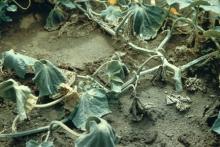Cause Fusarium oxysporum f. sp. melonis is a vascular fungus that can survive in soil indefinitely as durable spores (chlamydospores) or in association with plant debris. Seed can also transmit Fusarium wilt, usually by contamination of the seed coat. Melon seeds may have an internal infection just under the seed coat.
There is specialization within this fungal species towards various plant hosts affected. These formae speciales of Fusarium oxysporum, which incite Fusarium wilt on cucurbits are as follows: f. sp. cucumerinum (cucumber), f. sp. melonis (muskmelon), and f. sp. niveum (watermelon). There are also races within the formae speciales; at least three watermelon races, four melon races, and three cucumber races have been reported.
Symptoms The fungus can attack a susceptible plant at any stage of growth. Infection of the hypocotyl of young plants can result in pre- or post-emergence damping-off. Infection of older plants can cause yellowing (starting in the older leaves), stunting, or wilting, and once wilting occurs, death may result in 3 to 5 days. Affected melon plants may develop a lesion on the lower stem. The fungus affects the vascular system and infected plants may not show noticeable symptoms until they begin bearing fruit. Browning of the vascular system is usually evident in the lower stem, crown, or tap root. After the plant dies, a white mycelium mat may form on external plant surfaces. Root rot is not observed.
Cultural control
- Avoid planting on soil with a history of this disease, or practice long rotations (5 to 7 years).
- Plant clean, quality seed of resistant varieties.
- Plant resistant varieties such as All Star, Easy Rider, Superstar, Durango, Pulsar, Alaska, Roadside, Delicious 51, Harvest Queen, Classic, Harper Hybrid, Gold Star, Imperial, Earlisweet, and some strains of Honey Rock.
- Liming applications to bring the soil pH to 6.5 to 7.0 can reduce disease.
Chemical control
- Treat seed with Maxim 4FS at 0.08 to 0.16 fl oz/100 lb seed. For control of pathogenic Fusarium and Rhizoctonia spp. Treating weak or damaged seed may reduce germination and/or seed and seedling vigor.
- Preplant fumigation is recommended in the Hermiston area with metam sodium (Vapam HL) at various rates; see label for details. Restricted-use pesticide.
Biological control
- Actinovate AG at 3 to 12 oz/A as a soil drench at planting. 4-hr reentry. O
- Actinovate Lawn & Garden at 0.5 to 1 teaspoon/gal water. H O
- Bexfond at 7 to 28 fl oz/A for soil applications at planting via drenches, in-furrow applications, drip irrigation, or sprays, followed by irrigation, and reapplied at 4- to 8-week intervals. 4-hr reentry. O
- Double Nickel LC at 1 to 2 quarts/A as a banded soil spray or drench 4- to 6-week intervals or at 0.5 to 4.5 pints/A on 2- to 4-week intervals. Can be applied the day of harvest. 4-hr reentry. O
- Rootshield WP at 3 to 8 oz/100 gal water for greenhouse soil drench and field chemigation, or at 16 to 32 oz/A as an in-furrow spray. 4-hr reentry. O


